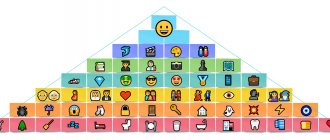“What am I doing?” - this question arises in everyone’s head from time to time. Is this the right basket where I put my thoughts and energy? Are my ways of achieving my goals correct? Is the operating system optimal? The answers to these questions are given by a simple but effective method of prioritization - the Eisenhower Matrix. This prioritization technique will be discussed in the post.
- Who invented the matrix and why is it needed?
- How to work with the matrix
- Square A
- Square B
- Square C
- Square D
Problems that the Eisenhower Matrix helps solve
Sometimes you work all day straight, you manage to do a bunch of things, you literally spin around like a squirrel, but the result is only fatigue and no satisfaction. Because it’s not very clear how all this labor heroism brought you closer to your goal.
In time management, this is called the problem of goal setting, and its consequences can be the most destructive - life turns into a grueling marathon with rare breaks and unclear results.
King Sisyphus was sentenced to forever roll a huge stone up a mountain, which fell down as soon as it reached the top. Nobody sentenced us to this, although sometimes it seems that we simply missed the announcement of the verdict.
Source
It is important to understand that the problem is not that we work little or poorly, but that before starting any business we do not set the right goals and do not determine priorities. One way to help sort this out is to use the Eisenhower Matrix to quickly sort tasks by priority.
A few related tips for organizing and saving time
Use these tips when implementing the Eisenhower Method:
- Don't overload yourself with unimportant things.
- Keep your workplace clean and don’t waste time looking for documents; train yourself to be tidy.
- Try to do important things in the first half of the day, and not in the evening, when activity declines.
- Best the enemy of the good. Take the matter seriously, but without fanaticism.
And one last piece of advice. Choose one direction in which you prefer to understand best. It's impossible to know everything.
The essence of the Eisenhower matrix
This technique helps you quickly sort through your to-do list, even if there are a lot of them. Outwardly, everything looks extremely simple - we look at the list of tasks and answer two questions for each one.
- It is important?
Not really
- This is urgent?
Not really
Take a sheet of paper and divide it into four parts. We get four squares in which we enter the answers to these two questions.
What does the Eisenhower Matrix look like?
Several tricks
1. At the very beginning, you can keep a list of your main goals and values at hand: this “cheat sheet” will help you evaluate tasks faster and more accurately.
2. If in your life there is a clear line between work and personal life (for example, you work strictly from 8-00 to 17-00), create two separate matrices. If this line is not so obvious (for example, you are a small business owner or a freelancer), then it is more convenient to keep all your affairs in one place.
3. Use color codes to quickly find tasks in your list from the desired square. Often it is enough to “color” only the problems from square A.
4. If you use an organizer, set up automatic repetition for tasks that you have to do regularly (monthly payments, weekly workouts, etc.). In this case, you will not have to re-distribute these tasks between the squares each time.
5. If you are under time pressure and want to have time to do all the most important things, prioritize within the squares themselves. For example, mark the most important and urgent task as “A1”, the second priority as “A2”, etc. Tasks from square D do not need to be marked.
6. If you want to assess the importance and urgency of your affairs even more accurately, add additional cells to the matrix. For example:
Quadrant A: important and urgent matters
- Things that, if not completed, jeopardize the achievement of the goal.
- Problems that need to be solved in order to avoid big difficulties in life.
- Health issues.
If you are a monster of efficiency, then this quadrant will be empty for you: you simply will not get things done until you get into the “fire” sector. But you're not an efficiency monster (and neither are we), so that's unlikely to happen. The most important thing is that things happen there infrequently and in small quantities. If half of your task list is there, it’s a disaster.
However, there is no need to panic. In order for this quadrant to be empty, you first need to work on maintaining the other sectors.
Characteristics of quadrants
To help you understand how to fit tasks into the quadrants, below is a detailed explanation for each of them.
Quadrant A (important and urgent)
If this quadrant has 2 or more items daily, pay attention to self-discipline. Ideally, there are no records in this sector. This indicates a person’s organization and active life position. In case of laziness and eternal procrastination “for tomorrow,” quadrant A will always be filled.
Set priorities correctly and do not allow an eternal list of important and urgent matters in the sector.
If you ignore the And quadrant and still fail, enter into it cases that meet the following requirements:
- These are matters whose urgent failure will have a negative impact on your health.
- Failure to do these things will certainly lead to failure, crisis and trouble.
- If you put off a task until later, it is impossible to achieve the final goal.
In quadrant A we enter all tasks related to family, health and career. If you are a student, studying is also a priority area.
Give up the principle: if you want to do it well, do it yourself. This is fundamentally wrong. Successful people who have mastered delegation significantly relieve their day.
Delegation allows you to entrust the execution of a task to another person, but the responsibility for the quality of the work performed lies with the person who delegated. Teach an employee to do it well and without adjustments once and use his skills later. Enter the tasks correctly and everything will work out.
Quadrant B (important and not urgent)
In quadrant B you need to include important matters that do not require extreme urgency. For example, you work in a large organization, your task is promotion. The decisive factor in achieving the goal will be the production optimization project. The manager expects the final numbers by Monday, but you have everything ready on Wednesday. Naturally, the issue is important, but does not require urgent implementation. By Monday, you can still double-check the report several times and make sure there are no hiccups.
Quadrant B deserves special attention. Ideally, it should be filled, and quadrant A should be empty. If you can achieve this in practice, you are on the path to financial success. Solve important and non-urgent tasks every day and live a happy, rich life full of bright emotions, develop, build a career and earn more money, use leverage to the maximum to achieve your goals.
Don’t let things get to the point of rush, focus on the main thing and complete tasks one by one with high quality. Get results using the Eisenhower Method.
Quadrant C (not important and urgent)
The appearance of unimportant but urgent matters is difficult to predict. For example, the coffee maker broke down. Repairing kitchen equipment is not the first priority, but freshly brewed coffee still gives strength and optimism in the morning. Starting the day with a fragrant cup of an invigorating drink is much more pleasant than without it. Do you understand the essence of the C quadrant?
The Eisenhower method of time planning is ideal, the main thing is to correctly delimit tasks. You will learn this over time. Let's look at another example.
The home appliance store has a promotion on all vacuum cleaners. Today only you can purchase any with a 50% discount. Yours broke a long time ago, but you can manage without it, and the offer is tempting.
So, let's figure it out. Is buying a vacuum cleaner important to you now?
In principle, you can wait, if not for one “but”: the discount attracts you.
This is urgent?
Yes, because the vacuum cleaner is available at an attractive price only today.
Now do you understand what principles are used to select cases for quadrant C? Don't rush into distribution. Take the Eisenhower table seriously and the time investment will be compensated when you see the effects of the Eisenhower method.
Quadrant D (not important or urgent)
A person cannot constantly keep himself in tension and solve only vital problems. Sometimes we need a reboot and the to-do list from quadrant D will provide us with it.
Some believe that this is a waste of time and that unnecessary things will not bring any benefit and will lead to degradation. Of course, this applies to nicotine and alcohol abuse. There is no point in arguing here. But what if we are talking about conversations with friends and family, for example? We are part of society and without neutral communication we will turn into robots that perform daily effective tasks. Social networks will inform you about changes in the lives of classmates, and reading an interesting book will charge you with enthusiasm and give you new knowledge.
In addition, based on the requirements of drawing up the Eisenhower diagram, quadrant D should include things that bring us comfort and pleasure, namely: going to a restaurant with a loved one, visiting a hairdresser, or attending exhibitions and concerts. These activities are pleasant and beneficial for both men and women.
Rarely does the D quadrant get any attention. It usually stays clean. But psychologists strongly recommend writing down and marking tasks that bring moral satisfaction and emotional relief.
How to Apply the Eisenhower Matrix to Time Management
There are many different, sometimes not very compatible, methods and techniques in time management. And this is not a disadvantage, since people are different. What works great for one person won't work for another. Therefore, you will inevitably have to try different techniques, choosing the right one.
Get started now. Eisenhower matrix template and try to fill it out.
Important! It may not work right away, but even the first attempts will help you gain an idea of the priorities of your current affairs and tasks.
And for a more serious study of time management, we recommend taking a course on project management.
You may already be good at managing your time.
What if you don't need Eisenhower's methods and are just fine with problems without tables? Ready to decide right now?
Then answer these questions honestly:
- Do you always make a to-do list?
- Do you respond to emails on time?
- Do you go home on time and working on the weekend is not about you?
- Does social media and chatter interfere with important tasks?
- At the end of the day, are you irritable and feeling like you could have done more?
- Do you always pay due attention to your family?
Think about whether you want to change the current state of affairs or leave everything as it is. Eisenhower Table - Your planning assistant.
A little history
The Eisenhower Matrix, as you might guess, was named after its creator. Dwight Eisenhower was born on October 14, 1890 into a poor religious family. In 1910, he entered West Point, as he dreamed of a military career, and already in 1918 he received the rank of lieutenant colonel. True, he didn’t have time to go to the First World War, but he found his place in the War Ministry.
Then World War II began - then he became a colonel and chief of one of the headquarters, after which he received a lot of flattering reviews from the generals with whom he served. Afterwards, he took up the post of head of the military planning department, commanding American forces in Britain. He became famous precisely at the conference held on this occasion.
The colonel did a lot to defeat the Nazis and was directly involved in the procedure for signing the act of surrender of Germany. With the rank of general, he retired and became president of Columbia University. Next came the creation of the American Assembly, command of the joint NATO armed forces and American military forces in Europe during the Korean War, which pushed Dwight into politics.
This path led to the inauguration on January 20, 1953, and the former military man became the 34th president in US history, gaining 55.2% of the vote. He held his chair until 1961.
Why this little historical background? It only proves that the Eisenhower Matrix as a tool for setting priorities really works - it is unlikely that a person who has achieved such impressive success could use a useless, non-working method.
How to determine the importance of a task
It is not enough to understand what the essence of the Eisenhower matrix is - you need to learn how to fluently evaluate things and distribute them into lists. We don’t want to sit endlessly over the quadrants; it’s better to focus on execution?
Ask yourself questions:
- If I postpone a task, will it become irrelevant?
- Will I have problems or miss an opportunity?
This is how urgency is defined. And now these questions:
- How does this fit my purpose?
- It's important for me?
Now we have learned the importance. Let's move on to priority:
- Can I postpone the matter?
- How important is this point to me, my goals and values?
Done – your project is sent to the desired quadrant!
It is better not to add more than eight points to one sector. As you progress, you can replenish the quadrant, but it is not advisable to do this. At least in the beginning.
Quadrant 2: Decide when to do it
Tasks in Segment 2 are important but not urgent. This is where you want to invest the majority of your time. The objectives in this quadrant of the Eisenhower Matrix align with your long-term goals .
What are examples of these problems? Obviously, these are long-term planning goals . Or for example, exercise is important for your health, but you can decide when to do it. You should also spend time with your family, but again, this needs to fit around your schedule.
In your career, you may benefit from further education or training in a new professional skill. These things are good for your career, but they don't need to be done immediately.
Here you should understand that everyone has different goals and objectives. So just because something falls into Quadrant 2 for you, it doesn't mean it does for the other person. Also, just because these things aren't urgent doesn't mean they aren't important.
People often associate urgency with importance, which is not always true . Since your goals remain the same, everything that will benefit you in the long term gets second priority according to the Eisenhower method.
❸
How to Balance Your Quadrants of the Matrix
According to Stephen Covey, Segment 2 is the “Quality Quadrant,” where spending time on these tasks improves your overall effectiveness . This is where personal and professional growth meets planning, prevention and action.
To assess where you are on the Eisenhower Priority Matrix, start tracking your time and goals. If you keep a planner for time management, you can easily see a list of all the activities you have completed and when you completed them.
Once you have several days' worth of data, sit down and organize your activities into quadrants by asking the following questions:
- Was it urgent for me?
- Was this important to me?
Remember that you are choosing these criteria only based on the results you want, not anyone else's.
Check the effectiveness of the matrix in practice
You can use the Eisenhower Matrix not only to determine which tasks bring you closer to the intended result, and which ones create obstacles on the way to your goal. You can also use this method to assess how effective you are overall. So, if all your tasks are placed in the second quadrant, we can say that you have reached maximum efficiency.
In addition, dividing tasks into quadrants allows you to visually determine where exactly the majority of your time and energy goes, and also tells you how to improve your personal productivity. For example, seriously think about delegating most tasks to other team members or finally stop wasting time and energy on things that find a place in quadrant No. 4.
You can optimize the use of the Eisenhower matrix method using applications that already exist in various versions: mobile, web and desktop versions. And in order to avoid making mistakes in setting goals and determine rational ways to achieve them, use the SmartProgress . With its help, more than 35,000 goals have already been realized by various people. Have you defined your goal?
- Tweet
- Share 0
- VKontakte
- 1
- Login to have your vote counted
Quadrant 1: do it immediately
Quadrant 1 contains tasks that are both urgent and important . These are “do first” things because they are significant to your life or career in some way and need to be done immediately. You feel that these things are critical.
These are things that need to be done to avoid negative consequences . It is important to be able to manage goals in this quadrant of the Eisenhower Matrix.
An example of a Segment 1 mini-goal in your career could be responding to a time-sensitive email from a client.
This matrix can also be used in your personal life. An example of such a function in personal life could be registering a newborn baby, shoulder pain and the requirement to find a massage therapist, or buying tickets for tomorrow's train.
❷











